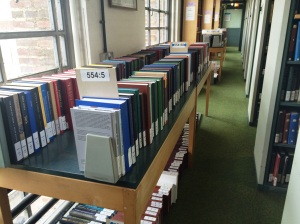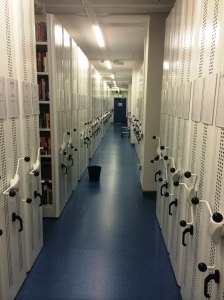
Many of you will have noticed the groaning shelves around the library, and our attempts to accommodate the continuous supply of new material. We move things around, we take away lesser consulted items, we remove the very large “a” size material, constantly revisiting and looking for ways in which to give our readers easy access to what they most need. It is not an easy task. Books keep coming, and overflows grow.
In European Collections and Cataloguing we are trying to address this, by looking carefully at what we send to the open shelves. As we catalogue an item, we decide where it should stand, going through a checklist of decisions in our minds. Firstly, should it be borrowable or non-borrowable? Wanting readers to have easy access to an item, we would prefer to make it borrowable where possible, only making it non-borrowable if it were particularly expensive or rare, if it had many plates and illustrations, or if it were either very large or conversely quite slight.
So … having made a decision that an item should be borrowable, how do we decide whether it should go on the open shelves or be placed in a closed class, such as 9000s (for 20th century publications) or C200s (for anything published in the year 2000 or later)? We think carefully about the language it is in. How many people will read it? Is it a critical edition of a literary work? Is it about something mainstream or core to that country’s civilization? Is it written by a leading academic in the field? What size is it? Is it illustrated? All these questions will have a bearing on our decision.

If we decide to place a book on closed access, we are not casting a negative judgement on the book, or regretting its purchase in any way. A huge proportion of what we, the language specialists, buy in ECC will end up on closed access. We are aware of that as we make our selection. It doesn’t stop us buying. Nor should it. These items will, for the most part, still be borrowable, but space in the library is at the moment at a premium. Much as we would like to, we cannot place everything on the open shelves. So, we have to look at each item and ask ourselves whether, if placed on the open shelves, it justifies that position. Ultimately, for every item we place on the open stacks, something will have to be removed. Therefore, as a cataloguer, I ask myself, does the book in my hand justify occupying that space?
We are fortunate here that we have a fetching system that works swiftly and efficiently. As we catalogue foreign language material, we do so in the knowledge that C200 and 9000 classes can be fetched quickly and easily to the Reading Room from whence they can be borrowed. It shouldn’t take much longer than if the reader were able to fetch the item from the open stacks. Both methods work well, both type of classes are important. Closed and open. We have had to adjust because of space issues, and we have done so in the best way we can.
Bettina Rex


Really interesting insight into how books are arranged in the UL and the thought that goes into where they end up. It also reminds us of the scale and volume of acquisitions. Thank you.